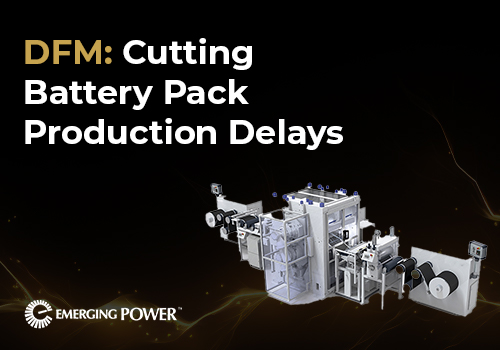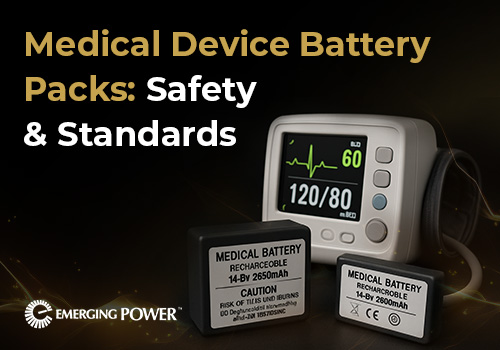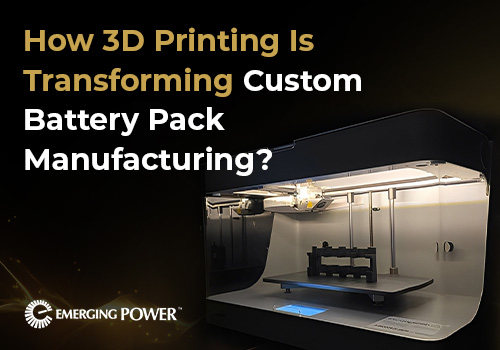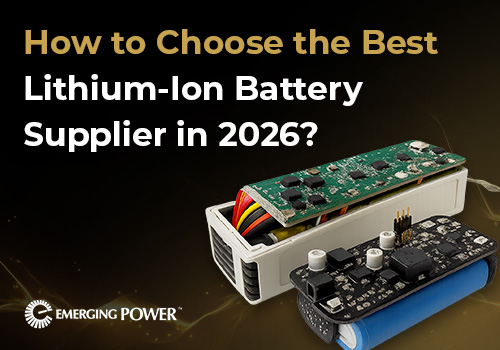In custom battery pack manufacturing, delayed production timelines cost more than just time—they mean lost revenue, missed market opportunities, and competitive disadvantage. While most companies focus exclusively on perfecting product specifications, they overlook the critical factor that determines on-time delivery: Design for Manufacturing (DFM).
At Emerging Power, our 40+ years of battery design and assembly experience have proven one fundamental truth: the decisions you make in the earliest planning stages have the most profound impact on production timelines, costs, and quality. This article reveals how integrating DFM principles from day one transforms battery pack development from a source of delays into a strategic advantage.
What is Design for Manufacturing in Battery Pack Production?
Design for Manufacturing is a proactive engineering approach that considers manufacturing constraints, assembly processes, and production realities during the initial design phase, not as an afterthought. In battery pack development, DFM encompasses everything from cell selection and BMS integration to enclosure design and testing protocols.
The principle is straightforward: designs that are easier to manufacture are faster to produce, more reliable, and more cost-effective.
The Hidden Costs of Poor Planning
When battery pack projects skip thorough early-stage planning, the consequences cascade throughout production:
- Late-stage design changes require expensive redesigns when manufacturability issues surface during prototyping
- Supply chain disruptions from components with long lead times or limited availability
- Quality issues stemming from designs that don’t account for real-world manufacturing tolerances
- Certification delays when safety and regulatory requirements aren’t integrated from the start
A recent medical device project demonstrates this perfectly. The initial design featured custom-shaped cells that would have added 8-12 weeks to the lead time. Through early planning discussions, our team proposed a configuration using standard cell formats with a custom enclosure instead—maintaining the same form factor while reducing lead time by 10 weeks.
Three Ways Early DFM Planning Accelerates Battery Pack Production
1. Optimized Component Selection Prevents Supply Chain Delays
The battery supply chain has become increasingly volatile. Selecting components without considering availability creates production bottlenecks that can halt your entire timeline.
Our Approach: During initial project planning, our engineering team evaluates cell chemistries, BMS components, and connectors based not just on performance but also on:
- Supplier reliability and lead times
- Component availability at required volumes
- Alternative options for critical parts
- Supply chain stability across the project lifecycle
Real Impact: Projects using 80% or more standard, readily available components experience 50% fewer supply chain delays. We leverage our established relationships with leading manufacturers, including Panasonic, Samsung, LG, and Moli Energy, to ensure component access.
2. Design for Assembly (DFA) Reduces Production Cycle Time
Complex assembly sequences slow production and increase defect rates. Early DFA integration simplifies manufacturing workflows from the start.
Our Approach: We optimize designs to:
- Minimize part count and assembly steps
- Position components for easy access during assembly
- Use modular designs allowing parallel assembly of subcomponents
- Eliminate unnecessary fasteners through snap-fit or adhesive bonding
- Create integrated wire harnesses instead of multiple small connections
Real Impact: By designing with assembly in mind, we’ve helped customers reduce assembly time by 30-40% compared to their initial designs. This directly translates to faster production ramp-up, lower labor costs, and improved delivery timelines.
3. Integrated Compliance Planning Eliminates Certification Delays
Battery packs require rigorous safety testing and regulatory certification (UL, IEC, UN38.3). Designs that don’t incorporate these requirements from day one often fail initial testing, requiring costly redesigns.
Our Approach: Our project management process integrates safety and regulatory requirements during the design phase:
- Proper spacing and isolation per safety standards
- Temperature monitoring and protection features
- Enclosure design meeting flammability requirements
- Documentation and test protocols aligned with certification needs
Real Impact: A medical device manufacturer achieved first-time UL certification by integrating requirements early, eliminating an estimated 8-week redesign and recertification cycle. For military and defense applications, our AS9100:2016 certification ensures compliance with stringent aerospace and defense standards.
The Emerging Power DFM Advantage
What sets our approach apart is our consultative engineering partnership. We don’t just execute your design—we collaborate to optimize it for manufacturing success.
Our comprehensive process includes:
✓ Early Design Review: Collaborative assessment of requirements, performance specifications, and production constraints
✓ Manufacturability Analysis: Evaluation of assembly sequences, tooling needs, and quality control checkpoints
✓ Supply Chain Validation: Component availability verification and long-lead-time item procurement
✓ Integrated Testing: Test protocols and certification requirements built into the initial design
This systematic approach has delivered thousands of custom battery solutions across diverse industries, including military/defense, medical devices, industrial OEM, communications, and instrumentation.
We offer the latest in battery technologies, including lithium-ion, lithium polymer, lithium iron phosphate (LiFePO4), lithium primary, and nickel metal hydride—all optimized for manufacturability without compromising performance.
Key Takeaways: DFM Best Practices for Battery Pack Development
Based on our 120+ years of collective manufacturing experience, these principles have the greatest impact:
- Engage manufacturing expertise early during the concept phase when design flexibility is highest
- Prioritize standard components from reliable suppliers with stable supply chains
- Design for testability to accelerate quality control and reduce defect rates
- Build manufacturing requirements into specifications from day one
- Plan for iteration with schedule buffers for optimization
Conclusion: Turn Early Planning into Competitive Advantage
In battery pack manufacturing, speed to market matters. Every week of delay represents lost revenue and a competitive disadvantage. Design for Manufacturing isn’t just about easier production it’s about transforming your development process into a strategic advantage.
By integrating DFM principles from the earliest planning stages, you can reduce time-to-market by 30-50%, lower production costs, improve product quality, and achieve first-time certification success.
At Emerging Power, our ISO 9001:2015 and AS9100:2016 certifications demonstrate our commitment to quality and reliability. Our consultative approach ensures every project benefits from decades of DFM expertise across commercial and military applications.
Ready to Accelerate Your Battery Pack Project?
Don’t let production delays derail your timeline. Contact Emerging Power today to discover how our DFM-focused approach delivers on-time, high-reliability battery solutions.
Contact Our Engineering Team | Call (201) 441-3590
Learn more about our project management capabilities and how we can help you through your most complex design and manufacturing challenges. The earlier we’re involved in your project, the better your results.









